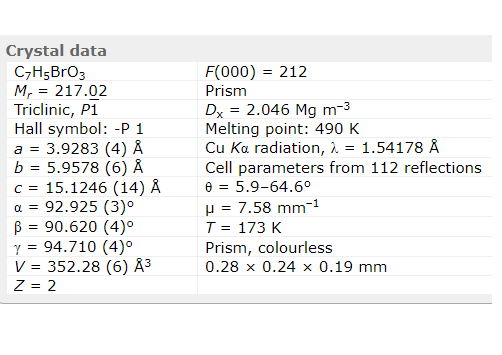| Identification | More | [Name]
4-Bromo-2-hydroxybenzoic acid | [CAS]
1666-28-0 | [Synonyms]
4-BROMO-2-HYDROXYBENZOIC ACID
4-BROMOSALICYLIC ACID
4-Bromo-2-Hydroxybenzoic Acid 2-Hydroxy-4-Bromobenzoic Acid
2-Hydroxy-4-bromobenzoicacid
4-Bromo-2-hydroxybenzoic acid 98% | [EINECS(EC#)]
624-267-3 | [Molecular Formula]
C7H5BrO3 | [MDL Number]
MFCD06797970 | [Molecular Weight]
217.02 | [MOL File]
1666-28-0.mol |
| Chemical Properties | Back Directory | [Melting point ]
164-165°C | [Boiling point ]
330.2±32.0 °C(Predicted) | [density ]
1.861±0.06 g/cm3(Predicted) | [storage temp. ]
Keep in dark place,Inert atmosphere,Room temperature | [form ]
powder | [pka]
2.71±0.10(Predicted) | [color ]
Orange | [InChI]
InChI=1S/C7H5BrO3/c8-4-1-2-5(7(10)11)6(9)3-4/h1-3,9H,(H,10,11) | [InChIKey]
FYAKLZKQJDBBKW-UHFFFAOYSA-N | [SMILES]
C(O)(=O)C1=CC=C(Br)C=C1O | [CAS DataBase Reference]
1666-28-0(CAS DataBase Reference) |
| Safety Data | Back Directory | [Hazard Codes ]
Xi | [Risk Statements ]
22-52/53 | [Safety Statements ]
S22:Do not breathe dust .
S24/25:Avoid contact with skin and eyes . | [RIDADR ]
2811 | [WGK Germany ]
3 | [Hazard Note ]
Irritant | [HazardClass ]
IRRITANT | [PackingGroup ]
Ⅲ | [HS Code ]
2918290090 |
| Hazard Information | Back Directory | [Chemical Properties]
4-Bromo-2-hydroxybenzoic acid is a solid at normal temperature and pressure. It is stable at normal temperature and decomposes into phenol and carbon dioxide after rapid heating. It has some acidic properties. | [Uses]
2-Hydroxy-4-bromobenzoic acid is used as an anti-scorch agent in drug molecules and rubber industry, as well as an intermediate in the production of ultraviolet absorbers and foaming agents. | [Synthesis]
Under nitrogen atmosphere, add copper (II) bromide (8.8 g, 39.4 mmol, 1.2 equivalents), acetonitrile (50 ml), and 4-aminosalicylic acid (5.1 g, 49.5 mmol) to the vacuum-dried reaction flask, 1.5 equivalent). The reaction mixture was cooled to 0°C, and 2-hydroxy-4-bromobenzoic acid precursor (5.0 g, 32.6 mmol, 1.0 equiv) was added portion-wise. Additional acetonitrile (25 mL) was added to the mixture and stirred at 0 °C for 2 h. The organic extracts were combined and washed with 20% aqueous hydrochloric acid, dried over magnesium sulfate, filtered, and concentrated under reduced pressure. The residue was dissolved in diethyl ether, and the resulting solution was extracted with 15% sodium hydroxide aqueous solution. The aqueous solution was washed with diethyl ether, acidified to pH 1 with 6N hydrochloric acid aqueous solution, and the mixture was extracted with diethyl ether. The combined organic extracts were washed with brine, dried over magnesium sulfate, filtered, and concentrated under reduced pressure. The residue was treated with chloroform, and the precipitate collected by filtration was 4-Bromo-2-hydroxybenzoic acid.
|
| Questions And Answer | Back Directory | [Structure]
4-Bromo-2-hydroxybenzoic acid is almost planar (r.m.s. deviation for the non-H atoms = 0.035??) and an intra-molecular O—H?O hydrogen bond closes an S(6) ring. The plane defined by the non-H atoms of the carboxyl group is twisted slightly by 4.8?(4)° to the mean plane of the phenyl ring. In the crystal, inversion dimers linked by pairs of O—H?O hydrogen bonds generate  (8) loops. Short Br?Br contacts [3.4442?(5)??] between the mol-ecules of the adjacent (8) loops. Short Br?Br contacts [3.4442?(5)??] between the mol-ecules of the adjacent  (8) dimers leads to a one-dimensional architecture. (8) dimers leads to a one-dimensional architecture.

|
|
|